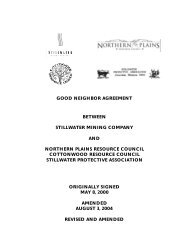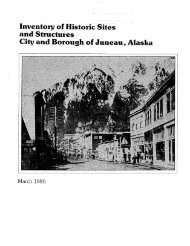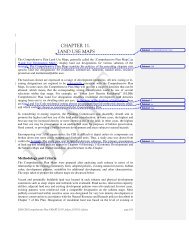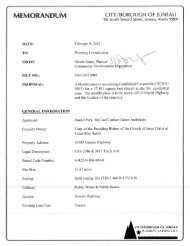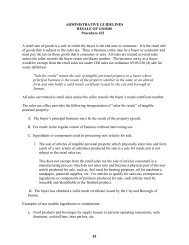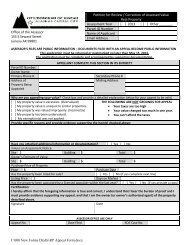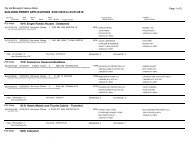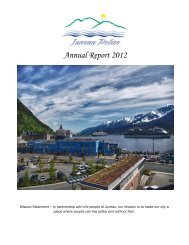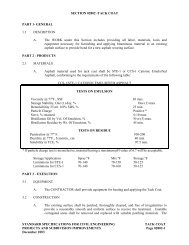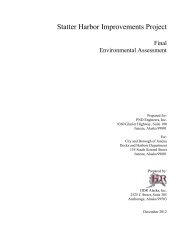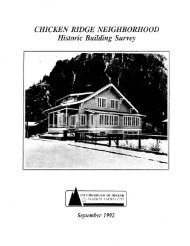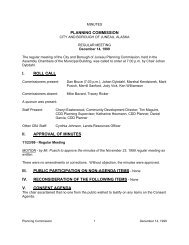Historical Context - The City and Borough of Juneau
Historical Context - The City and Borough of Juneau
Historical Context - The City and Borough of Juneau
You also want an ePaper? Increase the reach of your titles
YUMPU automatically turns print PDFs into web optimized ePapers that Google loves.
<strong>The</strong> Community<br />
Harris <strong>and</strong> <strong>Juneau</strong> reached Gastineau Channel in August 1880 <strong>and</strong> sampled the gravel <strong>of</strong> Gold<br />
Creek. <strong>The</strong>y found plenty <strong>of</strong> color, but did not follow the gold to its source. At Cowee's urging, Pilz<br />
sent the pair back again. This time Harris <strong>and</strong> <strong>Juneau</strong> climbed Snow Slide Gulch at the head <strong>of</strong> Gold<br />
Creek <strong>and</strong> located the mother lode <strong>of</strong> Quartz Gulch <strong>and</strong> Silver Bow Basin. <strong>The</strong>ir discovery led to<br />
the settling <strong>of</strong> <strong>Juneau</strong>, the first town founded in Alaska following the 1867 purchase from Russia. On<br />
October 18, they staked a 160-acre town site. <strong>The</strong>ir claim was entered into the record by Harris:<br />
"This is to certify that R.T. Harris, Joseph <strong>Juneau</strong>, <strong>and</strong> N.A. Fuller have this date<br />
recorded 160 acres for purposes <strong>of</strong> erecting a town site, commencing at a point<br />
one mile above the mouth <strong>of</strong> Gold Creek <strong>and</strong> running up the coast one-half mile<br />
<strong>and</strong> along the bay <strong>and</strong> anchorage right opposite Douglas Isl<strong>and</strong>, to be surveyed<br />
into 59 foot lots running back 200 feet, Said town site named <strong>and</strong> styled<br />
Harrisburg. October 18, 1880. R.T. Harris, Recorder."<br />
Harrisburg, Rockwell, or <strong>Juneau</strong> as it eventually came to be known, was situated on the shore <strong>of</strong><br />
Gastineau Channel under the shadows <strong>of</strong> Mount Roberts <strong>and</strong> Mount <strong>Juneau</strong>. A mining camp located<br />
on the beach, <strong>Juneau</strong> was composed <strong>of</strong> tents <strong>and</strong> cabins constructed <strong>of</strong> trees that grew throughout the<br />
town site, <strong>and</strong> supplies <strong>and</strong> materials brought from Sitka.<br />
Development in the fledgling town continued with the construction <strong>of</strong> the Log Cabin Church in<br />
1881, the Northwest Trading Company which was the first retail store in Harrisburgh, <strong>and</strong> the<br />
military post Rockwell. George Pilz shipped a pre-framed building from Sitka which became the<br />
first structure in town. In March 1881, Master Gustave Carl Hanus, a Navy <strong>of</strong>ficer from Sitka, ran<br />
lines to formally survey the new town which extended from the waterfront to a prominent ridge less<br />
than a mile away. <strong>The</strong> ridge area was later called Chicken Ridge. By the end <strong>of</strong> 1881, the town had<br />
a code <strong>of</strong> local laws, a Board <strong>of</strong> Public Safety to enforce them, <strong>and</strong> a post <strong>of</strong>fice.<br />
Construction proceeded at a steady pace <strong>and</strong> soon the town began to take shape. <strong>The</strong> downtown<br />
business district developed almost immediately. Court House Hill, later known as Telephone Hill,<br />
<strong>and</strong> nearby sections were quickly settled <strong>and</strong> as the population grew additional l<strong>and</strong> was staked <strong>and</strong><br />
cleared. Scattered houses were constructed on the wooded hillsides northeast <strong>of</strong> the business<br />
district. A Native village was established on the waterfront on the current site <strong>of</strong> Willoughby<br />
Avenue. Cabins for miners began to appear on Starr Hill, a working class residential area <strong>and</strong> by<br />
1893, the area <strong>of</strong> Chicken Ridge was being settled. In the nine years following the discovery <strong>of</strong> gold,<br />
<strong>Juneau</strong>'s population grew 800 percent from 150 to more than 1,200.<br />
Gold mining was the driving force behind this growth. At first the l<strong>and</strong> was placer mined; then<br />
prospectors attempted to work the larger, higher grade quartz veins they encountered by drilling <strong>and</strong><br />
blasting to break the gold-bearing quartz from the surrounding waste rock. Eventually, the<br />
prospectors began to consolidate adjoining properties <strong>and</strong> attack the deposit <strong>of</strong> quartz veins on a<br />
larger scale. By the 1890's, several <strong>of</strong> the small mining companies consolidated on a large scale <strong>and</strong><br />
out <strong>of</strong> this came the Treadwell, Alaska Gastineau, <strong>and</strong> the Alaska <strong>Juneau</strong> mining companies.<br />
As mining grew <strong>and</strong> large companies exp<strong>and</strong>ed the workings, it became apparent that <strong>Juneau</strong> would<br />
not be just another "boom <strong>and</strong> bust" gold camp. Rather, it enjoyed a growing prosperity built in the<br />
draft Casey Shattuck Neighborhood Historic Buildings Survey Page 13



